Click on images to enlarge

habit (Photo: Sheldon Navie)

habit in flower (Photo: Sheldon Navie)
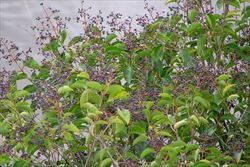
habit in fruit (Photo: Sheldon Navie)

bark on main trunk (Photo: Sheldon Navie)
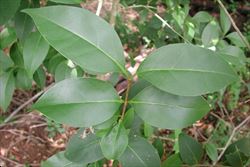
leaves (Photo: Sheldon Navie)

leaf undersides (Photo: Sheldon Navie)

flower buds (Photo: Sheldon Navie)
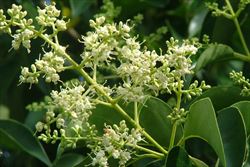
branched flower cluster (Photo: Sheldon Navie)

clusters of young fruit (Photo: Sheldon Navie)
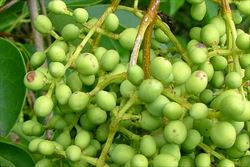
close-up of immaturre fruit (Photo: Sheldon Navie)

large clusters of mature fruit (Photo: Sheldon Navie)

close-up of mature fruit (Photo: Sheldon Navie)
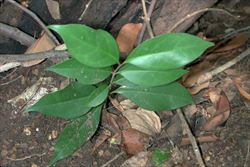
seedling in dense rainforest (Photo: Sheldon Navie)

close-up of seeds (Photo: Steve Hurst at USDA PLANTS Database)

Ligustrum lucidum 'Tricolor' (Photo: Sheldon Navie)
Scientific Name
Ligustrum lucidum W.T. Ait.
Family
Oleaceae
Common Names
broad leaf privet, broad-leaf privet, broadleaf privet, broad-leaved privet, Chinese glossy privet, Chinese liguster, Chinese privet, Chinese wax leaved privet, Chinese wax-leaf privet, Chinese white-wax tree, glossy privet, large leaf privet, large-leaf privet, largeleaf privet, large-leaved privet, ligustrum, Nepal privet, privet, tree privet, wax leaf privet, white wax tree, white waxtree
Origin
Native to eastern Asia (i.e. China, Korea and Japan).
Cultivation
Broad-leaved privet (Ligustrum lucidum) has been widely cultivated in eastern and southern Australia. It is still commonly seen in gardens, though legislation has reduced its popularity in some regions. There are also numerous cultivars of this species available, the most common of which is a form with variegated leaves known as Ligustrum lucidum 'Tricolor'.
Naturalised Distribution
This species is mainly naturalised in the wetter parts of south-eastern and eastern Australia. It is most common in south-eastern Queensland and in the coastal and sub-coastal districts of New South Wales, but is also present in Victoria, the ACT and on Norfolk Island.
Widely naturalised in other parts of the world, including southern Africa, temperate Asia, New Zealand, Hawaii, southern and eastern USA, and southern South America.
Habitat
Mainly a weed of wetter sub-tropical and warmer temperate regions, but occasionally also recorded in tropical and cooler temperate areas. It is often cultivated as a hedge or windbreak, and has often become naturalised in and around rainforest areas. Also a weed of open woodlands, grasslands, pastures, waste areas, disturbed sites, roadsides and waterways.
Habit
Usually a small tree growing 4-12 m tall, but occasionally a large tree reaching up to 25 m in height.
Distinguishing Features
- a small tree with leathery, hairless, oppositely arranged leaves.
- its relatively large dark green leaves (4-24 cm long and 2.5-8 cm wide) are glossy in appearance.
- its small white flowers (about 6 mm across) are borne in large branched clusters (8-25 cm long) at the tips of the stems.
- its bluish-black 'berries' (5-10 mm long) are borne in large attractive clusters.
Stems and Leaves
The stems and leaves are hairless (i.e. glabrous) and the younger stems are rounded (i.e. terete) and greenish in colour. Older stems and branches usually develop a relatively smooth greyish-coloured bark as they mature, which is loosely covered with small white raised structures (i.e. lenticels). However, the fruit-bearing branches often turn orange or reddish in colour.
The leaves vary from egg-shaped in outline (i.e. ovate) to oval (i.e. elliptic) in shape and are borne on short stalks (i.e. petioles) 10-30 mm long. These leaves (4-24 cm long and 2.5-8 cm wide) are hairless (i.e. glabrous), leathery in texture, and oppositely arranged along the stems. Their upper surfaces are dark green and glossy in appearance, while their undersides are paler and duller (i.e. the leaves are discolorous). They have entire margins, pointed tips (i.e. acute apices) and rounded (i.e. obtuse) bases.
Flowers and Fruit
The small flowers (about 6 mm across) are white or cream in colour and have four petals (2-5 mm long) that are fused at the base into a very short tube (i.e. corolla tube). They also have four tiny sepals (1.5-2 mm long) and two stamens. These flowers are borne in large branched clusters (8-25 cm long) at the tips of the branches (i.e. in terminal panicles). They are borne directly on the branches of the flower clusters or on short stalks (i.e. pedicels) 1-3 mm long (i.e. they are sessile or sub-sessile). Flowering occurs mostly during spring and summer.
The small fruit (5-10 mm long and 4-6 mm wide) are berry-like (actually drupes) that turn bluish-black or purplish-black in colour as they mature. These fruit are oval (i.e. ellipsoid) or round (i.e. globular) and each usually contains two seeds. The seeds have a ribbed surface and are about 5 mm long. Fruit are present during autumn and winter.
Reproduction and Dispersal
This plant reproduces by seed, which are readily dispersed by fruit-eating (i.e. frugivorous) birds and other animals. They may also be spread about by water and in dumped garden waste. The bunches of mature fruit are also used in flower arrangements.
Environmental Impact
Broad-leaf privet (Ligustrum lucidum) is regarded as an environmental weed or potential environmental weed in Victoria, New South Wales, Queensland and the ACT. It is currently of most concern in south-eastern Queensland, where it is ranked among the top 20 most invasive plants, and eastern New South Wales. This species causes widespread and significant environmental damage, and was recently listed as a priority environmental weed in seven Natural Resource Management regions. Its annual seed production is enormous, it can invade relatively intact rainforest communities, and it quickly outcompetes riparian vegetation. Broad-leaf privet (Ligustrum lucidum) can form dense thickets, particularly in coastal areas, which shade out and displace rainforest species. This can transform the habitat available to native animals, creating an ecosystem dominated by weeds, and disrupt the access of animals to natural corridors.
In New South Wales broad-leaf privet (Ligustrum lucidum) has become an invasive weed of rainforests, gullies and creek banks in coastal districts north from Bega, on the far south coast, and inland to West Wyalong. Abundant fruiting populations of this weed support artificially high numbers of pied currawongs (Strepera graculina ) in New South Wales, disrupting the natural ecological balance and adversely affecting other native birds. It is widely distributed throughout south-eastern Queensland and can also be found on the Atherton Tablelands, in northern Queensland. Small naturalised populations also exist in north-eastern and southern Victoria, where it is regarded as a potential threat to grasslands, woodlands, riparian vegetation and sclerophyll forests.
Other Impacts
The leaves and fruit of this species are poisonous to livestock and humans. In South Africa, broad-leaf privet (Ligustrum lucidum) pollen is known to cause significant irritation to hay fever sufferers.
Legislation
This species is declared under legislation in the following states and territories:
- ACT: C4 - prohibited pest plant (a pest plant whose propagation and supply is prohibited).
- New South Wales: Class 4 - a locally controlled weed. The growth and spread of this species must be controlled according to the measures specified in a management plan published by the local control authority and the plant may not be sold, propagated or knowingly distributed (in a large number of local authority areas). See the New South Wales Department of Primary Industries Noxious Weeds List at http://www.dpi.nsw.gov.au for more detailed information on which local areas are covered in these declarations.
- Queensland: Class 3 - this species is primarily an environmental weed and a pest control notice may be issued for land that is, or is adjacent to, an environmentally significant area (throughout the entire state). It is also illegal to sell a declared plant or its seed in this state.
- Western Australia: Prohibited - on the prohibited species list and not permitted entry into the state.
Management
For information on the management of this species see the following resources:
- the Biosecurity Queensland Fact Sheet on this species, which is available online at http://www.dpi.qld.gov.au.
- the New South Wales Department of Primary Industries Agfact on privets, which is available online at http://www.dpi.nsw.gov.au.
Similar Species
Broad-leaved privet (Ligustrum lucidum) is very similar to Chinese privet (Ligustrum sinense) and common privet (Ligustrum vulgare). It is also relatively similar to Indian hawthorn (Rhaphiolepis indica). These species can be distinguished by the following differences:
- broad-leaved privet (Ligustrum lucidum) has hairless (i.e. glabrous) younger stems and grows up to 12 m or more tall. Its relatively large leaves (4-24 cm long) have entire margins and are present year-round (i.e. it is evergreen).
- Chinese privet (Ligustrum sinense) has somewhat hairy (i.e. pubescent) younger stems and usually only grows to about 3 m tall. Its relatively small leaves (2-7 cm long) have entire margins and are usually present year-round (i.e. it is evergreen).
- common privet (Ligustrum vulgare) has hairless (i.e. glabrous) or finely hairy (i.e. puberulent) younger stems and grows up to 5 m tall. Its relatively small leaves (2-6 cm long) have entire margins and are often lost during winter (i.e. it is deciduous).
- Indian hawthorn (Rhaphiolepis indica) has hairless (i.e. glabrous) or slightly hairy (i.e. puberulent) younger stems and usually grows up to 2 m tall. Its moderately-sized leaves (3-7 cm long) have coarsely toothed (i.e. serrate) margins and are usually present year-round (i.e. it is evergreen).
Broad-leaved privet (Ligustrum lucidum) may also be confused with native privet (Ligustrum australianum), which is present in northern and central Queensland. However, native privet (Ligustrum australianum) has smaller leaves (4-7.5 cm long) and flowers (i.e. petals about 2 mm long). It is sometimes also confused with various native rainforest species when not in flower or fruit, including cheese tree (Glochidion ferdinandii) and many of the lilly-pilly's (Syzygium spp.).

